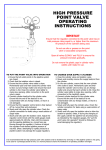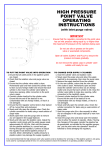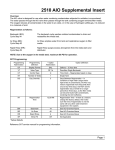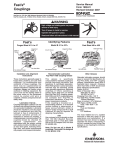Transcript
MANUAL MANIFOLD OPERATING INSTRUCTIONS NO SMOKING OR NAKED FLAMES USE NO OIL OR GREASES IMPORTANT - Ensure that the regulator connected to the manifold has an inlet pressure rating equal to, or higher than the maximum fill pressure of the cylinders being used. - Do not use oils or greases on the manifold or associated components. - Open all valves SLOWLY and FULLY to ensure the pressure increases gradually. - Do not remove the plastic caps in cylinder valve outlets until ready for use. TO PUT THE MANIFOLD INTO OPERATION 1. Ensure that all outlet points in the pipeline system are closed. 2. Check that valves “B” and “B1” on the change-over block are closed. 3. Ensure that each cylinder valve outlet is clean. Momentarily open and then close each cylinder valve to blow out any foreign matter and ensure that each cylinder is full. Close each cylinder valve lightly to make slow opening, (after connection to the manifold), easier. 4. Connect cylinder leads/coils to the cylinder valve. Ensure that the ends of the leads/coils are not contaminated with any foreign matter, or that they are not damaged. NOTE: On commissioning a new gas pipeline system, it must be purged through with the working gas to ensure that no atmospheric air is present in the pipeline. TO OPEN THE WORKING “IN-USE” BANK 1. Ensure that the regulator control knob “E” is fully backed off (ie. turned fully anti-clockwise). 2. Slowly and fully open the cylinder valve “D” on the required “in-use” bank of the manifold. Check the cylinder connection for leaks using a weak solution of soapy water. 3. Slowly and fully open the valve “B” on the “in-use” bank of the manifold. Adjust the regulator control knob “E” until the outlet gauges reads approximately 50-100 kPa. Wait until the pressure into the pipeline stabilizes (ie. cannot hear gas flowing through the regulator). Slowly continue to adjust the regulator knob until the desired pipeline pressure is reached. If fitted, the pipeline isolation valve can also be used to control the rate at which the pipeline is pressurized. (Note: attempting to rapidly pressurize the pipeline system may damage the supply regulator). TO CHANGE OVER TO THE “RESERVE” BANK 1. Slowly and fully open the cylinder valve “D1” on the “reserve” bank. Check the cylinder connection for leaks using a weak solution of soapy water. (Note: If the pipeline system empties before changing over, follow the “to open the working “in-use” bank” procedure). 2. Close the valve “B” on the empty working bank of the changeover block and immediately, but slowly, open the valve “B1” on the reserve bank. 3. Close the valve “D” on the empty cylinder. Remove the empty cylinder and replace it with a full one. 4. Ensure that new cylinder valve outlet is clean. Momentarily open, then close the cylinder valve to blow out any foreign matter and ensure that the cylinder is full. Close the cylinder valve lightly to make slow opening, (after connection to the manifold), easier. 5. Connect cylinder lead/coil to the cylinder valve. Ensure that the end of the lead/coil is not contaminated with any foreign matter, or that it is not damaged. TO CLOSE THE MANIFOLD DOWN 1. To shut the manifold down, close the “in-use” bank valve “B” on the change over block. 2. Check that the “reserve” valve “B1” is also closed. 3. Close the cylinder valves “D” and “D1” on the cylinders connected to the manifold. It is recommended that the manifold only be shutdown for servicing or if the pipeline system is not going to be used for a prolonged period of time. It is normal practice to leave the manifold in an operating condition overnight. Each time the manifold supply bank is changed over, the “reserve” bank becomes the “in-use” bank, and the previously “in-use” bank becomes the “reserve” bank.






